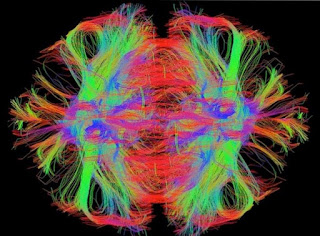Stretching the Boundaries of Our Creativity by Trevor Thorn
Partial Neural Pathways: A composite image
‘stitched’ together to symbolise our advanced but still
partial knowledge of how the brain works
Several years ago, my wife bought me a computer painting programme as a birthday present. It wasn’t cheap (of course!) but neither was it hugely expensive. It is called ‘Artrage’ although there are now a whole range of art generation programmes available and some are very modest indeed. I tend to doodle rather than draw/ paint but I have been amazed what can be achieved with a little practice. On the basis that the impact of a picture can be several times more powerful than the word (Dare one even whisper it on an author’s blog!), a programme of this nature opens up all sorts of unexpected possibilities, the most significant of which I would identify as follows:
- Building images can be done without having to get art materials out - and then tidy them away (unless you are fortunate enough to have a studio area).
- The features of such a programme allow for some extraordinary possibilities, such as blurring a layer; turning even a criss-cross of multi-coloured straight lines into a soft ‘maze’ of variegated intersections.
- Taking pictures and interpreting them in a way similar to the way the image at the top of this post has been manipulated (The original - posted by the Koch Institute - is the characteristic shape of the brain. The image above has been cropped half way across and then a copy inverted and put together; so you can see the mirroring of top left and bottom right).
- That even those who can only draw at a very simple level can construct simple cartoons (see illustration below) which will not have any copyright implications.
- Children who have reached the stage of being able to be trusted with electronic equipment can have a field day illustrating things you have written: some fascinating ideas can come out of such creativity.
And in the last of these, lies the idea which I find most fascinating about using such a programme - that of cross-fertilised creativity. As the brain engages with an emerging image, so words may emerge giving fresh slants for writing. Let me give you an illustrated example.
I was toying with a pattern of blurred wavy lines and realised I could set them against a pale blue/green background. By then putting the result into a oval section it looked just a little like the pictures of the cosmic microwave background. (Google it for a Wikipedially simple explanation). It was then possible to place the tiniest of white crosses at the heart of the image which suggested to me the sense of Christ as the ‘Source’ of all being. That became the title of the image and led on to a poem and a hymn: the first entitled ‘Sonnet of The Source’ and the latter ‘Source of the Fundamental Forces’.
Who knows, the willingness to dabble with minimal risk - unpromising material can easily be blitzed - just might even soothe away ‘writers block’ for some. It’s at least worth a try.
So, finally, as promised above a very simple sample cartoon
These images - and many others, many with associated poems, can be found on my blog at http://crossandcosmos.blogspot.com
Trevor Thorn.



Interesting ideas Trevor, thank you.
ReplyDelete